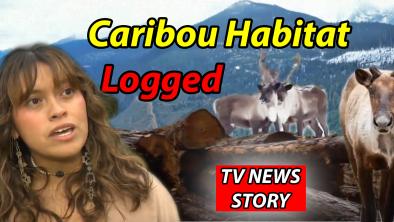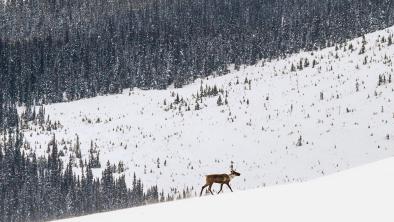B.C. government to destroy old-growth caribou habitat
Trail Times

Days after the province announced a new provincial approach to old-growth forests, conservation groups have learned that B.C. plans to log more than three square kilometres of intact rainforest north of Revelstoke, destroying endangered southern mountain caribou critical habitat.
While B.C. quietly advances plans to log the old-growth, the province is trumpeting spending of more than $33,000 to restore caribou habitat nearby.
“The B.C. government is taking two steps forward and three steps back by attempting to create habitat while also obliterating old growth currently usable habitat. It’s a net loss,” says Wilderness Committee Conservation and Policy Campaigner Charlotte Dawe. “The government is sabotaging itself and caribou, not to mention wasting taxpayer money, by logging right next door.”
On the ground investigation from Wildsight, Echo Conservation Society and the Wilderness Committee in the Argonaut Valley has revealed the planned logging will destroy a large area of primarily old-growth rainforest, with massive cedars and hemlocks over 50 metres tall and many hundreds of years old.
This comes right after a provincial review of old-growth forests found that a paradigm shift is necessary to manage B.C.’s old growth forests.
The authors recommended 14 steps to preserve the remarkable old-growth found in the province including immediately deferring logging in old forests where ecosystems are at high risk of irreversible biodiversity loss.
Argonaut Creek is one of these areas where biodiversity and old-growth forest is at-risk.
“The rainforest in the Argonaut Valley is an incredible place, with giant ancient cedars,” says Echo Conservation Society Executive Director Thomas Knowles. “B.C.’s interior rainforest is a hidden ecological jewel along the eastern edge of the province, but we’re letting it slip away to logging.”
This rainforest is critical habitat for endangered southern mountain caribou, which have recently disappeared from the southern part of their range in the Kootenays after two herds were lost in the Purcell and Selkirk mountains.
Mountain caribou have already been wiped off the map in southern B.C., mostly because of the destruction of their habitat through logging.
The North Columbia herd is the southernmost herd left in B.C. with the best chance at survival but they won’t survive if we keep clearcutting the old-growth forest they need.
These cutblocks are being auctioned off by BC Timber Sales, which is the provincial government’s own logging agency.
The groups are calling on the provincial government to cancel the auction of these primarily old-growth logging blocks and restore the five kilometres of already-constructed road.
“If B.C. won’t protect this critical caribou habitat, then federal Environment Minister Jonathan Wilkinson must use his powers under the Species at Risk Act and issue an emergency protection order to protect irreplaceable caribou habitat,” says Dawe.
The proposed clearcuts fall within the 150-member North Columbia herd’s critical habitat under Canada’s Species at Risk Act and tracking data shows that caribou use the area.
Logging and other industrial activity is largely blamed for the severe decline of southern mountain caribou to less than 1,200 animals. This population of deep-snow caribou survive by eating lichen from trees in the winter and are disappearing not just because of the loss of the old-growth forests they rely on, but also because of an increase in predators because of changes in forest ecosystems and backcountry roads that come with logging.
This summer, the B.C. government announced $1.1 million in funding for caribou habitat restoration.
Splatsin First Nation is leading a restoration project in the area and the province has devoted $33,000 to this effort.
Yet at the same time, the province is auctioning off cutblocks less than two kilometres from the area being restored.
In past years, the province has also spent significant sums on maternal penning for caribou in the North Columbia herd, culling predators like wolves and other measures.
“Habitat restoration is an incredibly important aspect of recovery,” says Knowles. “But it makes no sense to restore habitat, build maternity pens and kill predators for caribou and then turn around and cut down the old-growth forest they need to survive.”
With less than five per cent of the inland rainforest still standing as old-growth, conservation groups are asking why the province is allowing any logging of the little old-growth that remains.
British Columbians want their old-growth forests protected, not logged.
So why is B.C. planning to log one of the few remaining valleys of old-growth in the rainforest north of Revelstoke?
Click here to view the original article published by Trail Times.


